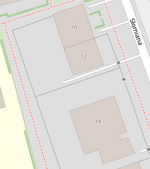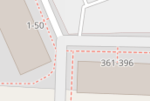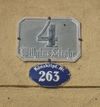Template:Map Features:addr
Jump to navigation
Jump to search
Addresses
This is used to provide postal information for a building or facility. See the pages titled Addresses and addr=* for an introduction on its usage.
| Key | Value | Element | Comment | Rendering | Photo | |
|---|---|---|---|---|---|---|
Tags for individual houses | ||||||
| addr:housenumber | user defined | The house number (may contain letters, dashes or other characters). Addresses describes ways to tag a single building with multiple addresses. Please do not only tag addr:housenumber=*, but also add at least addr:street=* or addr:place=* for places without streets (or map the belonging to a street with a relation using associatedStreet relation or street relation.) |

|
|||
| addr:housename | user defined | The name of a house. This is sometimes used in some countries like England, Spain, Portugal, Latvia instead of (or in addition to) a house number. |
||||
| addr:flats | user defined | The unit numbers (a range or a list) of the flats or apartments located behind a single entrance door. | 
|

| ||
| addr:conscriptionnumber | user defined | This special kind of housenumber relates to a settlement instead of a street. Conscription numbers were introduced in the Austro-Hungarian Empire and are still in use in some parts of Europe, sometimes together with street-related housenumbers which are also called orientation numbers. | ||||
| addr:street | user defined | The name of the respective street. If the street name is very long or nonexistent, the ref of the respective street. A way with highway=* or a square with place=square and the corresponding name should be found nearby. The belonging to a street can alternatively be represented by a associatedStreet relation or street relation. The keys addr:housenumber=* and addr:street=* in principle are the only necessary ones if there are valid border polygons. If you are not sure if it is so, just add addr:city=*, addr:postcode=* and addr:country=*. |
||||
| addr:place | user defined | This is part of an address which refers to the name of some territorial zone (usually a place=* like island, square or very small village) instead of a street (highway=*). Should not be used together with addr:street=*. | ||||
| addr:postcode | user defined | The postal code of the building/area. Some mappers prefer to rely on boundary=postal_code | ||||
| addr:city | user defined | The name of the city as given in postal addresses of the building/area. (In some places the city in the address corresponds to the post office that serves the area rather than the actual city, if any, in which the building is located.) Some mappers assume it can be derived from a boundary=administrative relation. | ||||
| addr:country | user defined | The ISO 3166-1 alpha-2 two letter country code in upper case. Example: "DE" for Germany, "CH" for Switzerland, "AT" for Austria, "FR" for France, "IT" for Italy. Caveat: The ISO 3166-1 code for Great Britain is "GB" and not "UK". More or less favoured in different national communities. |
||||
| addr:postbox | user defined | Use this for addressing postal service Post Office Box (PO Box, BP - Boîte Postale, CP - Case Postale, Поштански преградак, Поштански фах, Поштански претинац) as alternative to addressing using street names. Example: "PO Box 34" | ||||
| addr:full | user defined | Use this for a full-text, often multi-line, address if you find the structured address fields unsuitable for denoting the address of this particular location. Examples: "Fifth house on the left after the village oak, Smalltown, Smallcountry", or addresses using special delivery names or codes (possibly via an unrelated city name and post code), or PO Boxes. Beware that these strings can hardly be parsed by software: "1200 West Sunset Boulevard Suite 110A" is still better represented as addr:housenumber=1200 + addr:street=West Sunset Boulevard + addr:unit=110A. |
||||
For countries using hamlet, subdistrict, district, province, state, county | ||||||
| addr:hamlet | user defined | The hamlet of the object. In France, some addresses use hamlets instead of street names. | ||||
| addr:suburb | user defined | If an address exists several times in a city. You have to add the name of the settlement. See Australian definition of suburb. | ||||
| addr:subdistrict | user defined | The subdistrict of the object. | ||||
| addr:district | user defined | The district of the object. | ||||
| addr:province | user defined | The province of the object. For Canada, uppercase two-letter postal abbreviations (BC, AB, ON, QC, etc.) are used. In Russia a synonym {{{key:addr:region}}} is widely used | ||||
| addr:state | user defined | The state of the object. For the US, uppercase two-letter postal abbreviations (AK, CA, HI, NY, TX, WY, etc.) are used. | ||||
| addr:county | user defined | The county of the object. | ||||
Tags for interpolation ways | ||||||
| addr:interpolation | all/even/odd/ alphabetic | How to interpolate the house numbers belonging to the way along the respective street. See detailed description. |
||||
| addr:interpolation | Number n | Every nth house between the end nodes is represented by the interpolation way. | ||||
| addr:inclusion | actual/estimate/potential | Optional tag to indicate the accuracy level of survey used to create the address interpolation way. See detailed description. |
||||
This section is a wiki template with a default description in English. Editable here.
This documentation is transcluded from Template:Map Features:addr/doc. (Edit | history)
Note to editors: Please don't categorize this template by editing it directly. Instead, place the category in its documentation page, in its "includeonly" section.
Note to editors: Please don't categorize this template by editing it directly. Instead, place the category in its documentation page, in its "includeonly" section.
Template for the Addresses table in the Map Features page. Use the default English text or use the template arguments for your translations
Usage
All parameters are optional. By default, text is in English.
- English writers shall write their comments in the template itself (avoiding double edition).
- Other languages are translated in template arguments, not in the template itself.
- Headers/footers
- name = === Section header line ===
- description = Displayed before the table; optional
- Table column headers
- head:key = Key
- head:value = Value
- head:element = Element
- head:desc = Comment
- head:render = Rendering
- head:photo = Photo
- Table subsections (row groups)
- head:subsection = Text of the subsection header row
- For each table row for a tag whose key is addr:subkey
- addr:subkey:key = Key:addr:subkey
- addr:subkey:value = (subkey name)
- addr:subkey:desc = (Description)
- addr:subkey:render =
- addr:subkey:photo =
Template to copy/paste in translations
<noinclude>{{Languages}}
</noinclude>{{Map Features:addr
|name =
|description =
|addr:key =
|head:key =
|head:value =
|head:element =
|head:desc =
|head:render =
|head:photo =
|head:house_tags =
|addr:housenumber:value =
|addr:housenumber:desc =
|addr:conscriptionnumber:value =
|addr:conscriptionnumber:desc =
|addr:housename:value =
|addr:housename:desc =
|addr:street:value =
|addr:street:desc =
|addr:place:value =
|addr:place:desc =
|addr:postcode:value =
|addr:postcode:desc =
|addr:city:value =
|addr:city:desc =
|addr:country:value =
|addr:country:desc =
|addr:full:value =
|addr:full:desc =
|head:hamlet_subdistrict_district_province =
|addr:hamlet:value =
|addr:hamlet:desc =
|addr:suburb:value =
|addr:suburb:desc =
|addr:subdistrict:value =
|addr:subdistrict:desc =
|addr:district:value =
|addr:district:desc =
|addr:province:value =
|addr:province:desc =
|addr:state:value =
|addr:state:desc =
|head:interpolation_tags =
|addr:interpolation:value =
|addr:interpolation:desc =
|addr:interpolation:number:value =
|addr:interpolation:number:desc =
|addr:inclusion:value =
|addr:inclusion:desc =
}}






